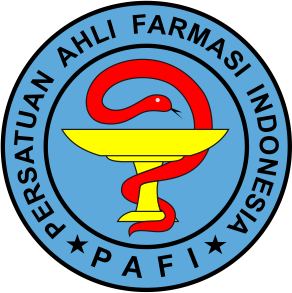Overview of Antipsychotic Use in Schizophrenia Patients at the East City Health Center in 2024
Abstract
Schizophrenia is a severe mental disorder that affects individuals and greatly impacts their families and society, with symptoms like hallucinations, delusions, and emotional or thought disturbances that disrupt daily life and well-being. Treatment for schizophrenia usually involves a combination of antipsychotic drug therapy, psychotherapy, and social support. This study aims to determine the description of antipsychotic use, including the type of drug, rules of use, drug dosage, and duration of use in schizophrenia patients at the Kota Timur Health Center. This study used a descriptive observational research design with data collection using a retrospective method. The research data were obtained from secondary data in the form of medical record data from as many as 25 patients with mental illness. The data were processed with Excel and analyzed using SPSS version 26. The results showed that schizophrenia was predominantly suffered by male patients (56%), and more were in the age range of 34-46 years (as many as 48%). The most widely used antipsychotic drugs were a combination of typical and atypical, as many as 92%. The most frequently used type of drug is clozapine with a dose of 25 mg, and the rules of use are 2 x 1/2 as much as 46%. The longest duration of treatment is already in the maintenance phase, which is 96%. Additional drug trihexyphenidyl 2 mg (2 x 1) is used as much as 92%. The most widely used type of therapy is 3-combination therapy, namely Risperidone + THP + Clozapine, as much as 56%. This study was conducted at the East City Health Center, Gorontalo, which is one of the largest primary healthcare facilities in the region and manages a considerable number of schizophrenia patients with limited psychiatric resources. Therefore, the study setting provides important insights into the real-world use of antipsychotic medications in a community-based healthcare center.
Keywords
Full Text:
PDFReferences
Alldredge, Brian K, Robin L Corelli, Michael E Ernst, B Joseph Guglielmo, Pamala A Jacobson, Wayne A Kradjan, and Bradley R Williams. 2013. Koda‐Kimble and Young’s Applied Therapeutics: The Clinical Use of Drugs. Wolters Kluwer Health Adis (ESP).
Amelia, Diny Rezki, and Zainul Anwar. 2013. “Relapse in Patients with Schizophrenia.” Jurnal Ilmiah Psikologi Terapan 1 (1): 53–65. https://doi.org/10.22219/jipt.v1i1.1357.
American Psychiatric Association. 2020. The American Psychiatric Association Practice Guideline for the Treatment of Patients With Schizophrenia. Washington, DC: American Psychiatric Association Publishing. https://doi.org/10.1176/appi.books.9780890424841.
Dania, Haafizah, Imaniar N. Faridah, Khansa F. Rahmah, Rizky Abdulah, Melisa I. Barliana, and Dyah A. Perwitasari. 2019. “Hubungan Pemberian Terapi Antipsikotik terhadap Kejadian Efek Samping Sindrom Ekstrapiramidal pada Pasien Rawat Jalan di Salah Satu Rumah Sakit di Bantul, Yogyakarta.” Indonesian Journal of Clinical Pharmacy 8 (1). https://doi.org/10.15416/ijcp.2019.8.1.19.
Fleischhacker, W. Wolfgang, and Hiroyuki Uchida. 2014. “Critical Review of Antipsychotic Polypharmacy in the Treatment of Schizophrenia.” International Journal of Neuropsychopharmacology 17 (7): 1083–93. https://doi.org/10.1017/S1461145712000399.
Ikawati, Zullies. 2014. Pharmacotherapy of Central Nervous System Diseases. Yogyakarta: Bursa Ilmu.
Indonesian Pharmacists Association. 2019. ISO Indonesian Drug Specialist Information, Volume 52. Jakarta: PT. ISFI Publishing.
Kementerian Kesehatan Republik Indonesia. 2013. Hasil Riset Kesehatan Dasar (Riskesdas) 2013. Jakarta: Badan Penelitian dan Pengembangan Kesehatan, Kementerian Kesehatan RI.
———. 2023. Formularium Nasional 2023. Jakarta: Kementerian Kesehatan Republik Indonesia. https://fornas.kemkes.go.id/.
Noviria, M, Triyoso, and L Yanti. 2015. “The Relationship between Family Support and Control Visits of Outpatients with Schizophrenia at Mental Hospital in Lampung Province 2013.” Jurnal Kesehatan 8 (2): 76–81. https://doi.org/10.26630/jk.v8i2.200.
Rahaya, Anggie, and Noor Cahaya. 2016. “Studi Retrospektif Penggunaan Trihexyfenidil pada Pasien Skizofrenia Rawat Inap yang Mendapat Terapi Antipsikotik di Rumah Sakit Jiwa Sambang Lihum.” Jurnal Farmasi Galenika (Galenika Journal of Pharmacy) (e-Journal) 2 (2): 124–31. https://doi.org/10.22487/j24428744.2016.v2.i2.5986.
Swayami, I. G. A. V. 2014. “Aspek Biologi Triheksifenidil di Bidang Psikiatri.” Universitas Udayana.
Wells, Barbara G, Joseph T Dipiro, Terry L Schwinghammer, and Cecily V Dipiro. 2015. Pharmacotherapy Handbook: Ninth Edition. New York: McGraw-Hill Education.
World Health Organization. 2016. “Schizophrenia.” Geneva: World Health Organization. https://www.who.int/news-room/fact-sheets/detail/schizophrenia.
———. 2019. Schizophrenia: Fact Sheet. Geneva: World Health Organization. https://www.who.int/news-room/fact-sheets/detail/schizophrenia.
Zahnia, Siti, and Dyah Wulan Sumekar. 2016. “Kajian Epidemiologis Skizofrenia.” Majority (Medical Journal of Lampung University) 5 (4): 160–66. https://doi.org/10.20884/1.jks.2021.16.3.1374.
DOI: http://dx.doi.org/10.52365/jecp.v5i2.1388
Article Metrics
 Abstract view : 70 times
Abstract view : 70 timesRefbacks
- There are currently no refbacks.
Copyright (c) 2025 Teti Sutriyati Tuloli, Andi Makkulawu, Khairunnisa Alya Sumaga, Madania Madania, Mohamad Reski Manno

This work is licensed under a Creative Commons Attribution-ShareAlike 4.0 International License.
Indexed in:
 Journal of Experimental and Clinical Pharmacy (JECP) by Department of Pharmacy, Poltekkes Kemenkes Gorontalo is licensed under a Creative Commons Attribution-NonCommercial 4.0 International License. | Support By: |











